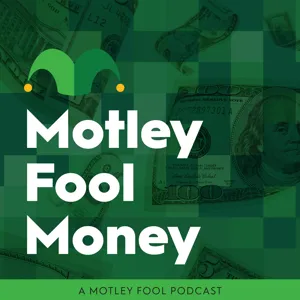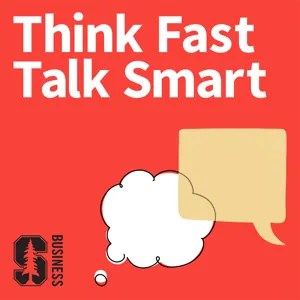Podcast Summary
Learn effective communication skills and understand intrinsic value: Improve communication skills through the Think Fast, Talk Smart podcast and learn intrinsic value through discounted cash flow models for personal and professional growth
Effective communication skills are essential in business and life, and the Think Fast, Talk Smart podcast can help you hone these skills. The podcast, which has received nearly 43 million downloads and is the number one career podcast in 95 plus countries, offers valuable insights from experts on various communication topics. Meanwhile, in the world of investing, understanding intrinsic value through discounted cash flow (DCF) models is crucial. John Ratanti explains that intrinsic value is the estimated business value based on a company's fundamentals, which is the present value of future free cash flows. By learning about communication skills and DCF models, you can improve yourself both personally and professionally.
Calculating Intrinsic Value of a Business: Size, timing, and riskiness of a business's future cash flows determine its intrinsic value, which is calculated by estimating and discounting these cash flows back to their present value using a discount rate reflecting the perceived risk level.
The intrinsic value of a business is calculated by estimating its future free cash flows and discounting them back to their present value. The size, timing, and riskiness of these cash flows are the three primary factors considered in this calculation. The size of the cash flow refers to its monetary value, while timing considers when the cash flow is expected to be received. The further out in time, the lower the present value of the cash flow. Lastly, the riskiness of the cash flow is incorporated into the calculation through the use of a discount rate, which represents the required rate of return for an investor based on the perceived risk level of the business. The stock market historically returns around 9-10% per year, so most investors aim for a higher return when evaluating businesses.
Discount rate's impact on intrinsic value: The discount rate used in valuation models influences the intrinsic value estimate, with higher rates reducing it and lower rates increasing it. Risk level and cash flow stability determine the appropriate discount rate.
The discount rate used in valuation models significantly impacts the estimated intrinsic value of a company. The higher the discount rate, the lower the estimated intrinsic value, and vice versa. This is because the present value of future free cash flows decreases as the discount rate increases. Investors must consider the risk level and cash flow stability of a company when determining an appropriate discount rate. For example, companies with high commodity price dependence or operating in cyclical industries may require a higher discount rate due to their inherent risk. Conversely, stable, low-risk businesses may warrant a lower discount rate. Understanding the relationship between discount rates and intrinsic values is crucial for accurate valuation analysis.
DCF Model's Structure: Forecast Period vs Terminal Period: DCF model estimates a company's intrinsic value by forecasting cash flows for a certain period and using a perpetuity formula for the remaining period. The forecast period length depends on confidence in assumptions and competitive advantage, while the terminal period uses a perpetuity formula with a discount rate.
A Discounted Cash Flow (DCF) model, which is used to estimate a company's intrinsic value, consists of a forecast period and a terminal period. The forecast period is the part of the model where assumptions about future revenue growth are made, typically for a period of 5 to 10 years. The length of the forecast period depends on the degree of confidence in the assumptions and the company's competitive advantage. The terminal period uses a mathematical formula, called a perpetuity, to estimate cash flows beyond the forecast period. The intrinsic value increases when the discount rate in the model is lowered. It's important to note that the further out the projection period, the less certainty there is in the assumptions. The best practice is to make the projection period as long as the company can maintain its competitive advantage. Most DCF models are 10 years long for practical reasons.
Estimating future financial performance using DCF analysis: To estimate a company's future financial performance using DCF analysis, model out revenues and operating margins for the next 10 years, calculate EBIT and NOI/CFFO, and make assumptions about tax rates.
In Discounted Cash Flow (DCF) analysis, to estimate the future financial performance of a company over the next 10 years, you need to model out revenues and operating margins. For revenues, you estimate the growth rate and multiply it with the current revenue to get the revenue estimate for the next year. You then repeat this process for each subsequent year. For operating margins, you estimate what percentage of revenue you believe the company can convert into operating income (EBIT) based on factors such as industry conditions, competition, and the company's ability to expand margins. You then multiply the revenue estimate for each year with the corresponding operating margin estimate to get the EBIT estimate for that year. Finally, you need to assume a tax rate to calculate the tax liability and arrive at the Net Operating Income (NOI) or Cash Flow from Operations (CFFO) for each year. All these estimates are subject to uncertainty and should be viewed as assumptions rather than definitive forecasts.
Calculating Free Cash Flow with Historical Tax Data: Determine industry tax rates, apply consistent tax rate for next 10 years, calculate NOPAT, subtract total reinvestment, discount FCF to find present value
When valuing a company, it's important to estimate and calculate the free cash flow (FCF) using historical tax data, operating income, and reinvestment into growth. First, determine the industry and peer average tax rates, then apply a consistent tax rate for the next 10 years. Next, calculate the net operating profit after tax (NOPAT) for each year by multiplying operating income and the tax rate. Subtract total reinvestment, which includes changes in working capital, capital expenditures, property, plant, and equipment, and acquisitions, to find the FCF. Finally, discount the estimated FCF from year 1 to year 10 using a chosen discount rate to find the present value.
Calculating Enterprise Value with Free Cash Flows and Terminal Value: To find a business's enterprise value, determine its free cash flows over a set period, calculate the terminal value using a sustainable growth rate, and sum the present values of both.
To calculate the enterprise value of a business, you need to determine the present value of its free cash flows over a certain projection period, and then add the present value of the perpetuity of its cash flows beyond that period. The terminal growth rate for the perpetuity calculation should be a reasonable and sustainable rate, not exceeding global GDP growth rate. The terminal value is calculated by multiplying the free cash flow in the last year of the projection period by 1 plus the terminal growth rate, and then dividing it by the cost of capital minus the terminal growth rate. Lastly, the terminal value needs to be discounted back to the present value using the same discount rate as for the free cash flows. The sum of the present values of the free cash flows in the projection period and the present value of the terminal value equals the enterprise value.
Valuing a company's stock involves more than just calculating equity value: To account for potential inaccuracies, create a base, bear, and bull case to estimate a range of intrinsic values per share
When valuing a company's stock, we first calculate the equity value by subtracting debt and adding any cash left over, then dividing by the number of fully diluted shares outstanding to get the estimated value per share. However, this estimate is not precise and can be wrong. To account for potential inaccuracies, we perform scenario analysis by creating a base case, bear case, and bull case to estimate a range of intrinsic values per share. The range of estimated fair values will be narrower for more predictable companies and wider for less predictable ones.
Estimating fair value for uncertain companies: For uncertain companies, a wider range of fair value estimates is necessary due to potential profitability and cash flow uncertainty. Thorough research and due diligence are crucial to accurately modeling potential paths to profitability and self-funding.
Estimating the fair value of a company, especially those in their early stages or not yet profitable, requires a wider range of estimates due to the uncertainty of future profitability and cash flow generation. Fair value is defined as the price at which you can pay for a stock and earn your required rate of return if your model is correct. If you pay fair value for a stock, you should expect to generate an annualized return roughly equal to your discount rate. However, for companies with higher uncertainty, the range of estimated fair values will be wider. It's important for investors to do thorough research and due diligence to model out potential paths to profitability and self-funding.






